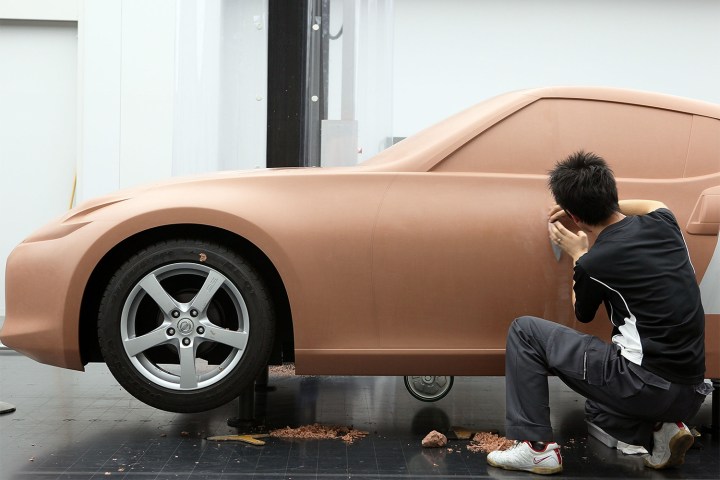
Henry Ford never actually uttered, “If I had asked people what they wanted, they would have said faster horses.” But 100 years later, Steve Jobs did in fact famously say, “People don’t know what they want until you show it to them.”
That may be true for visionaries like Ford, Jobs, and many others who bring disruptive products to market. But does that attitude work when auto designers create mass market products to compete for consumer attention? Digital Tends recently visited Buick’s design team at the GM Technical Center in Warren, Michigan. The famous mid-century modern building designed by architect Eero Saarinen has been home to GM’s design and engineering efforts since 1956. We asked several Buick designers how customer input and preference translates into vehicles offered for sale.
Reading between the lines
“We don’t design cars in a vacuum,” insisted Bob Boniface, director of design for Buick exteriors and interiors. “In our clinics we have a quantitative component where customers just rank and assign a number to the car [design]. Then there’s a qualitative portion where we have focus rooms. We ask people what they think.”
Even asking customers what they think of a design has a meta component. It’s about how the designers listen to the response.

“We may say, if you didn’t like this car, tell me why you didn’t like it,” Boniface explained. “We may learn something in their reasoning about why they didn’t like it. Perhaps they didn’t like it because they’re traditionalists and they only like what they have already seen. But, what they’ve said actually is good news, because it tells us where to take that process.”
“If you didn’t like this car, tell me why you didn’t like it.”
The process of focus grouping is more about getting to the customers’ underlying attitudes about cars.
“One thing we don’t do is ask them how they would design the car,” Boniface said. “If we show them a video of a car they may say, ‘I don’t like that, I want the grille moved up.’ So, OK the customer wants to move the grille up. We would never do anything like that. We take everything they say under advisement. It’s not like a compass, we don’t go where they tell us to go. We take their comments into consideration, but it’s just one data point for us.”
Balancing current and future customers
In some ways, Tesla had it easy. With no brand history to respect and no one expecting anything in particular, Elon Musk and his designers truly had a clean sheet of paper. Established brands have an existing client base that expects consistency, but it’s also imperative to bring new customers to the company with fresh ideas.

“We don’t want to have our design language going to a narrower part of the client population,” Boniface cautioned. “Actually it’s quite the opposite. We want to broaden our appeal and if we lose a few traditionals out there, then we hope they’re more than replaced by a younger demographic that can actually move through their life stages with us. That’s the way you move the brand forward.”
The automotive industry is in a period of rapid change, and brands like Buick with a century of history have to adapt while hopefully retaining their identity in the minds of consumers.
“The world of autonomous, electrics, fuel cells, all these things of the future are for younger buyers,” Boniface said. “Those are the people you want to bring to the brand now. But we don’t have a crystal ball at the moment.”
Respecting the past while looking to the future
Virtually every automaker likes to retain the signature design elements that make its brand distinctive and recognizable. The seven slots of a Jeep grille, or the dual kidney grilles of a BMW announce the car’s brand at a distance.
“We’ve got to find ways to appease customers in a way that they don’t expect.”
“We are not throwing away the traditional elements that have made the styling of Buick what it’s always been,” said Rob Cameron, design manager for Buick’s exteriors. “We mean it’s a re-interpretation. It’s introducing something that we feel is new and inspiring. We’re utilizing the principles that have founded our brand since the thirties, forties, and fifties. We point back to that and use it as inspiration. It’s not like a broken record, but it’s using principles that are kind of timeless you might say, to inspire yourself again.”
In the end, even when they’re working within the confines of the existing market and a long-established brand, there’s plenty of opportunity to imagine the future and invent the unexpected game-changer.
“It’s an exploration of the future of automobiles,” Cameron declared. “As the automotive market landscape is always changing, we’ve got to find ways to appease customers in a way that they don’t expect.”
Henry Ford and Steve Jobs would understand that perfectly.
Editors' Recommendations
- How crowdsourced lidar could give your car X-ray-like superpowers
- Bloodhound supersonic car can be yours for just $11 million
- Ford can use your voice to make your car’s wheels theftproof
- How do you get people to take your electric supercar seriously? Set a lap record
- Night or day, these stunningly bright LED highlights can improve your car’s visibility, safety


